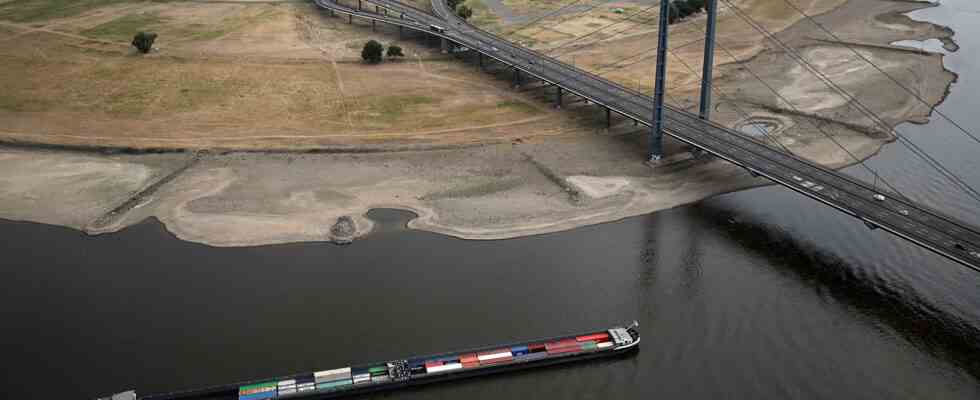Status: 08/15/2022 1:45 p.m
The low water levels are causing problems for German inland shipping. Traffic has not yet come to a complete standstill. According to Federal Transport Minister Wissing, the problem could worsen in the future.
On the Rhine, Germany’s most important waterway, there is no end to the extreme low water in the absence of rainfall – on the contrary: in North Rhine-Westphalian Emmerich near the border with the Netherlands, a record low water level of just four centimeters was measured.
This undercut the previous low of seven centimeters in autumn 2018. This was announced by the Waterways and Shipping Administration (WSV). According to the forecast, a level of zero could be reached as early as tomorrow. The most recent depth of the fairway in Emmerich, which is crucial for shipping, was just under two meters.
Rhine shipping: water level at Kaub at 32 centimeters
The water level near Kaub between Mainz and Koblenz in Rhineland-Palatinate also continued to fall at the beginning of the week: from 37 centimeters on Sunday to just 32 centimeters at the beginning of the new week. Kaub is considered an important hub for inland shipping on the upper Rhine. “Ships are still sailing, but fewer and with less cargo,” said the spokesman for the Rhine Waterways and Shipping Office, Florian Krekel, to the Reuters news agency about the consequences. “Traffic hasn’t completely stopped yet.”
Kaub is considered an important hub for inland shipping on the upper Rhine.
Image: dpa
For the next three to four days, it is predicted that the water levels further downstream on the Lower Rhine will fall by another five to ten centimeters, as the office emphasized. On the Middle Rhine, the level is likely to remain constant for the most part. “The 14-day forecasts continue to point to a slight increase in water levels from the middle of this week,” it said. “However, this is not significant, the water levels remain at a low level.” The lowest level so far was measured at 25 centimeters on October 22, 2018.
The Rhine ferry in Nierstein temporarily ceased operations in the morning. The cause is the extreme low water in the river, the company said in the Mainz-Bingen district. It is uncertain when the ferry will be able to drive again. Motorists now have to put up with considerable detours to get to the other side of the Rhine.
Shipping on the Upper Rhine largely discontinued
The logistics company Contargo Rhein-Neckar GmbH largely stopped shipping on the Upper and Middle Rhine. A few ships are still in operation, but they cannot be loaded to any significant extent, according to the Managing Director of Contargo Rhein-Neckar, Marco Speksnijder. according to information from swr.
Trucks and trains must therefore be used to transport goods. The containers are transported via a land bridge to a terminal in Duisburg and shipped on to the Lower Rhine. Inland shipping is currently still possible there. However, according to Speksnijder, the capacities for container transport on land are limited.
Ships only loaded with 600 tons
In Cologne, too, the water level is approaching the record low of 2018. “This has extreme effects on the Rhine waterway,” said the spokesman for Cologne Ports and Freight Transport, Christian Lorenz, to Reuters. He cited salt deliveries from Heilbronn as an example. Rock salt, which is important for the chemical industry, is transported across the Rhine. “At the beginning of March, the ships could still be loaded with around 2,200 tons,” said Lorenz. “Because of the low water levels, only 600 tons were finally possible.” In 2018, at times only 300 tons were feasible. “We’re getting closer to that,” the spokesman said.
Wissing: Always expect low water in the future
According to Federal Transport Minister Volker Wissing, the problem of low water levels could become even more acute in the future. “We have to face the fact that in the long term we have to be prepared for extreme low water situations due to climate change,” Wissing told the “Rheinische Post”.
The Rhine is the most important waterway in Germany. Because of the low water levels, ships can currently transport significantly less cargo. This increases the transport costs for the industry and exacerbates the already tense situation in logistics. Transport Minister Wissing spoke out in favor of expanding the infrastructure. It is “important that we implement measures such as bottleneck optimization on the Middle Rhine as quickly as possible,” he told the newspaper.
The Federal Association of German Inland Shipping (BDB) recently called for the rapid implementation of planned construction measures. Deepening of the fairways in the Rhine and Danube are particularly necessary.
Low water levels increase the risk of recession
The Rhine is one of the most important shipping routes in Germany. Raw materials such as grain, chemicals, minerals, coal and oil products are transported on it by cargo ship.
Economists now fear further losses for the already weakening German economy. According to experts from Deutsche Bank, Landesbank Baden-Württemberg and the Kiel Institute for the World Economy, if the water levels continue to fall, the risk of a recession will increase. Above all, the supply of the coal-fired power plants is at risk. They are increasingly needed for electricity production because Russia has throttled gas supplies.
“Slight rise in water levels”
A slight relaxation of the situation is to be expected in the coming weeks, Wissing said. The most recent six-week forecast by the experts in his company “points to a slight rise in water and a stabilization of the water levels at a low level”. The Federal Institute for Hydrology (BfG) recently predicted a “slight increase in water levels”.
However, the expected amounts of precipitation would be too low “to bring about a sustained relaxation of the low water situation on the larger rivers”. Restrictions on shipping are therefore to be expected in the future.

